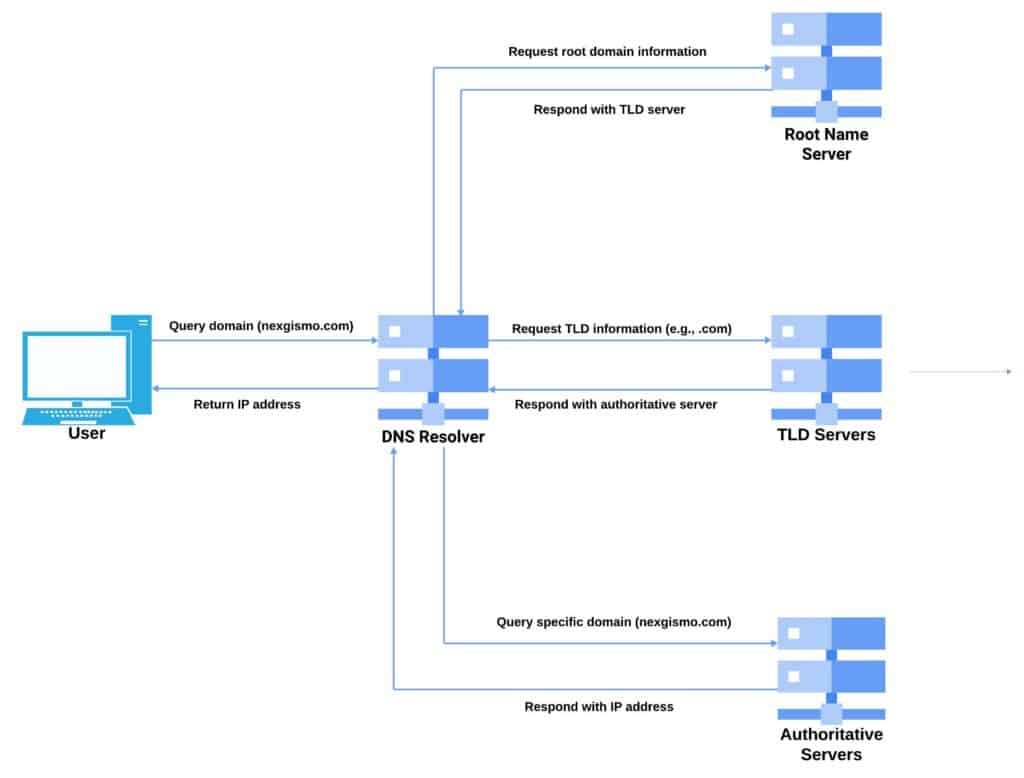
How Does DNS Resolution Work? A Detailed Journey By Nexgismo
Have you ever asked yourself what processes take place in the digital sphere when you enter a URL and how DNS resolution works? You know, typing nexgismo.com into your browser and pressing the enter button?
Understanding how DNS resolution works is crucial not just for tech enthusiasts, but also for web developers and network engineers. The Domain Name System (DNS) is often referred to as the “phonebook of the internet,” translating human-friendly domain names into IP addresses that computers use to identify each other on the network. This process, though seemingly instantaneous, involves multiple steps that ensure your request reaches the correct destination.
Such a thrilling ride the request you make through the internet is! Alright, let’s go and explore this journey together about DNS resolution and discover the process involved. But first, let’s take a brief look at the history and evolution of DNS.
Table of Contents
Step 1: DNS Resolution: Lost and asking for direction
Suppose you are searching for a new restaurant that has opened in your city. First, one goes around asking people the location of the house. Likewise, your browser must determine the IP address for nexgismo.com. This is referred to as DNS, or Domain Name System resolution.

Browser Cache
The browser first checks its own cache. Browsers store DNS records from previous sessions to speed up the loading process. If the IP address for www.nexgismo.com is in the cache, the browser can skip the DNS resolution process and connect directly to the server. This caching mechanism significantly improves performance and reduces latency.
Recursive DNS Resolver
If the IP address is not found in the browser cache, the next step is to query a recursive DNS resolver. This resolver can be provided by your Internet Service Provider (ISP) or third-party services like Google Public DNS or Cloudflare. The recursive resolver acts as an intermediary, responsible for making additional DNS queries on behalf of the client.
Root Servers
The recursive resolver first queries the root name servers, which are the highest level in the DNS hierarchy. These root servers direct the resolver to the appropriate Top-Level Domain (TLD) servers. There are 13 root servers, labeled A through M, strategically distributed around the world to ensure redundancy and reliability.
TLD Servers
The root servers point the resolver to the TLD servers, which manage top-level domains like .com, .org, and .net. For www.nexgismo.com, the resolver would be directed to the .com TLD servers. These servers then guide the resolver to the authoritative DNS servers for the specific domain.
Authoritative DNS Servers
Finally, the authoritative DNS servers know precisely where www.nexgismo.com lives. These servers hold the DNS records for the domain and provide the IP address required for the browser to connect to the website. Once the resolver obtains the IP address, it returns this information to the browser, completing the DNS resolution process.
Step 2: Creating a TCP Socket connection – The Handshake
Once the IP address is known, the browser needs to establish a connection with the server. This is done through a process known as a TCP (Transmission Control Protocol) handshake.
SYN: Your browser responds with, ‘Hello, can we talk?’ – an acknowledgment of SYN packet.
SYN-ACK: The server responds with ‘‘Sure, let’s chat!’’ (SYN-ACK packet).
ACK: This is acknowledged by your browser with the words “Great, let’s start!” in the ACK packet
This three-way handshake ensures that both the client and server are ready to communicate and that the connection is reliable.
Step 3: HTTPS/TLS Handshake – Establishing a Secure Connection
In today’s internet age, security is paramount. If the website uses HTTPS, an additional handshake process called the HTTPS/TLS handshake takes place to establish a secure connection.
Encryption Agreement: The two are agreed on how to encode the discussion.
Server Identity: The server produces a form of identification known as a digital certificate to prove its authenticity.
Session Keys: Both generate secret keys to ensure that the chat is secured from the reach of the third party.
Step 4: Sending the HTTP Request
With the secure connection established, the browser sends an HTTP request to the server.
GET Request: The browser requests the homepage of www.nexgismo.com by sending a GET request.
Step 5: Server Processing
The server processes the request by retrieving the required resources.
Processing Request: The server processes the request, runs any necessary scripts, and prepares the data.
HTTP Response: The server responds with the requested resources, including the HTML, CSS, and JavaScript files, along with a status code (e.g., 200 OK).
Step 6: Bringing the Data – Serving the Page
he browser now has all the necessary resources to display the webpage.
- Parsing HTML: The browser reads the structure of the web page from the HTML.
- Fetching Resources: The browser retrieves images, CSS, and JavaScript files.
- Executing Scripts: The browser executes JavaScript to add interactivity to the page.
- Applying Styles: The browser uses CSS to style the page.
- Rendering Layout: The browser arranges all elements to create the final layout of the webpage.
Step 7: Interactivity – Using the Page
The webpage is now fully loaded, and the user can interact with it.
User Interaction: You can now work with the webpage as you can click links, fill in forms, and perform many other actions. A single action may generate additional requests, creating a loop.
Wrapping Up
So, the next time you type www.nexgismo.com and press enter, you’ll understand how your request travels through the internet. From DNS resolution to establishing a secure connection, sending requests, and rendering the webpage – it’s all part of the Internet’s intricate process.
Conclusion
Understanding how DNS resolution works provides valuable insights for web developers, network engineers, and tech enthusiasts. The internet is a complex yet orderly system that operates around the clock to make information accessible. By delving into the intricacies of DNS and web technologies, you can better appreciate the seamless experience we often take for granted.
External Resources
You May Also Like:-

[…] Please Also Read :- What Happens When You Type a URL in Your Browser, and How Does DNS Resolution Happen? […]
[…] What Happens When You Type a URL in Your Browser, and How Does DNS Resolution Happen? […]